The Be Quiet! Straight Power 11 750W PSU Review: Excellent Quality, But Not Quiet
by E. Fylladitakis on November 7, 2018 8:00 AM EST- Posted in
- Cases/Cooling/PSUs
- PSUs
- 80Plus Gold
- 750W
- be quiet!
Hot Test Results
The electrical performance of the Straight Power 11 750W PSU is good, yet perhaps unimpressive considering the premium character of the product. Voltage regulation is good, at about 1.5% for the 12V and 5V lines and at 2.6% for the 3.3V line. Line filtering is good as well, with our instruments recording a maximum of 36 mV, 24 mV, and 24 mV on the 12V, 5V, and 3.3V lines respectively (with balanced loading), figures that are very well within the design guide limits.
| Main Output | ||||||||
| Load (Watts) | 152.39 W | 378.54 W | 564.36 W | 749.6 W | ||||
| Load (Percent) | 20.32% | 50.47% | 75.25% | 99.95% | ||||
| Amperes | Volts | Amperes | Volts | Amperes | Volts | Amperes | Volts | |
| 3.3 V | 2.2 | 3.4 | 5.49 | 3.4 | 8.24 | 3.34 | 10.98 | 3.32 |
| 5 V | 2.2 | 5.08 | 5.49 | 5.05 | 8.24 | 5.03 | 10.98 | 5 |
| 12 V | 10.98 | 12.18 | 27.45 | 12.1 | 41.18 | 12.03 | 54.9 | 11.99 |
| Line | Regulation (20% to 100% load) |
Voltage Ripple (mV) | |||||
| 20% Load | 50% Load | 75% Load | 100% Load | CL1 12V |
CL2 3.3V + 5V |
||
| 3.3V | 2.4% | 6 | 12 | 16 | 24 | 12 | 20 |
| 5V | 1.6% | 6 | 14 | 18 | 24 | 14 | 24 |
| 12V | 1.6% | 20 | 20 | 28 | 36 | 40 | 24 |
The Straight Power 11 750W PSU experiences a significant efficiency drop when the ambient temperature is very high. This drop is almost evenly distributed across the load range, suggesting that the components are not getting thermally stressed. Even so, the average efficiency reduction is 2.7%, with a substantial drop of 4.3% at 100% load. We should note that the 80Plus certification tests take place at room temperature and not under such adverse ambient conditions.
Even though the unit’s efficiency takes a substantial hit when the ambient temperature is high, the internal temperatures of the PSU are very low. Our instruments recorded temperatures just above 75 degrees with the unit operating at maximum capacity, when the majority of other designs lands close to 90 degrees. It is not clear why the designers of this PSU chose to have this much headroom, especially with a unit primarily designed with quiet operation in mind, but such low internal temperatures will certainly aid with the longevity of the PSU.
Expectedly, the fan’s cooling profile is much more aggressive now that the ambient temperature is very high, which is the culprit behind the exceptional thermal performance of the Straight Power 11 750W PSU. The obvious shortcoming of this approach is that the fan is audible even when the PSU is lightly loaded, while it reaches uncomfortable noise levels once the load surpasses 350-400 Watts. Considering that quiet operation is the major selling point of this PSU, its thermal design surely is peculiar.


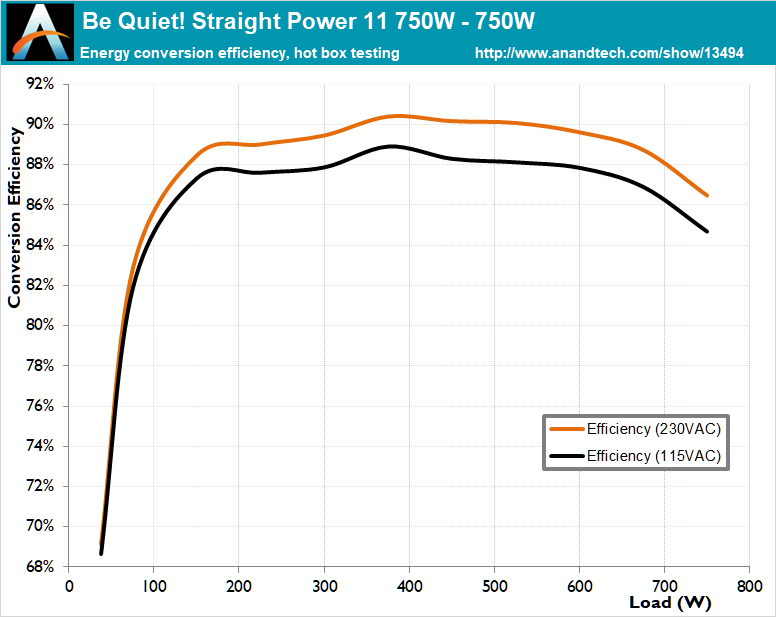
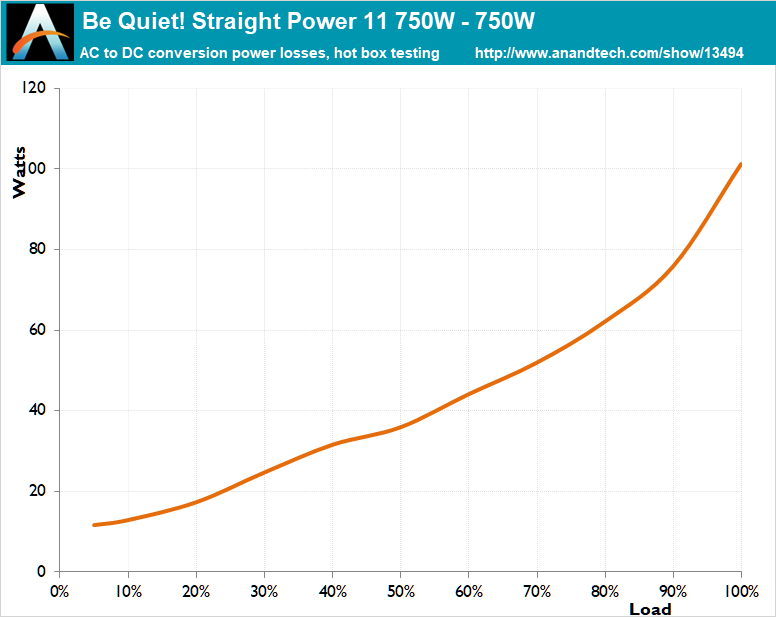
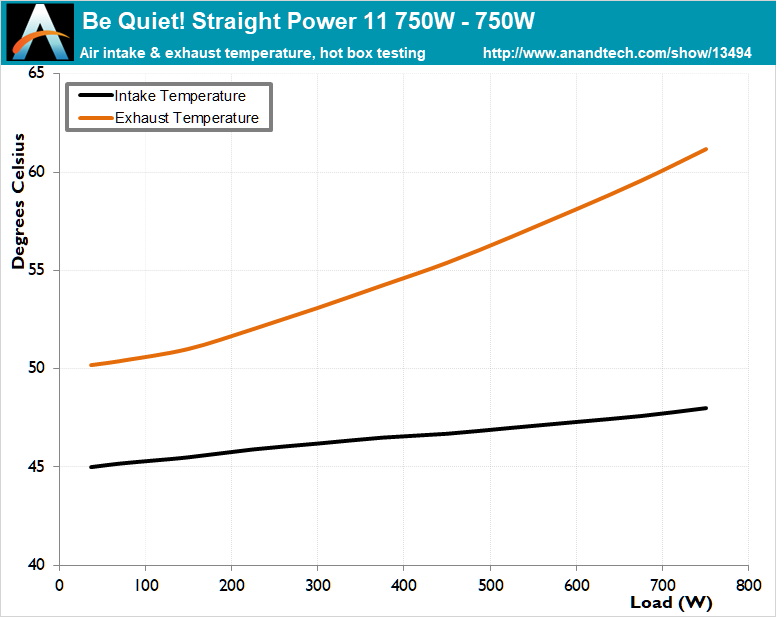
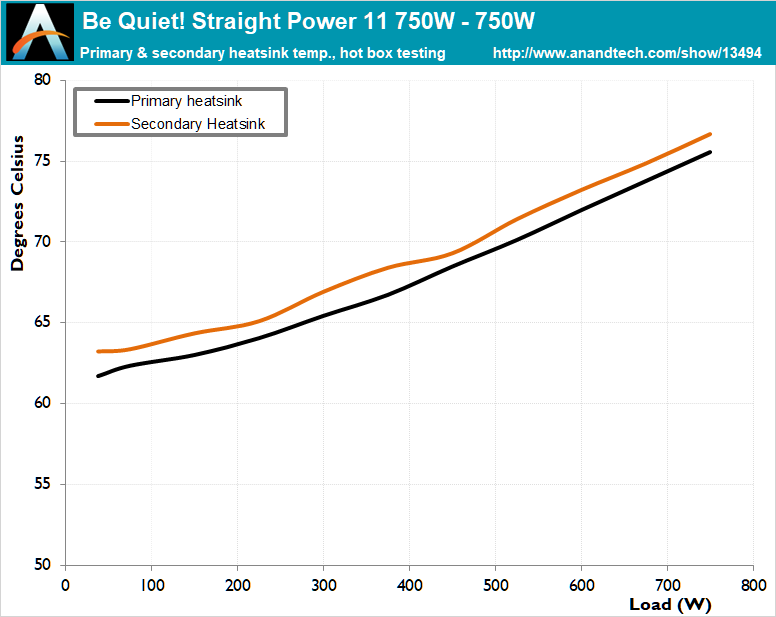
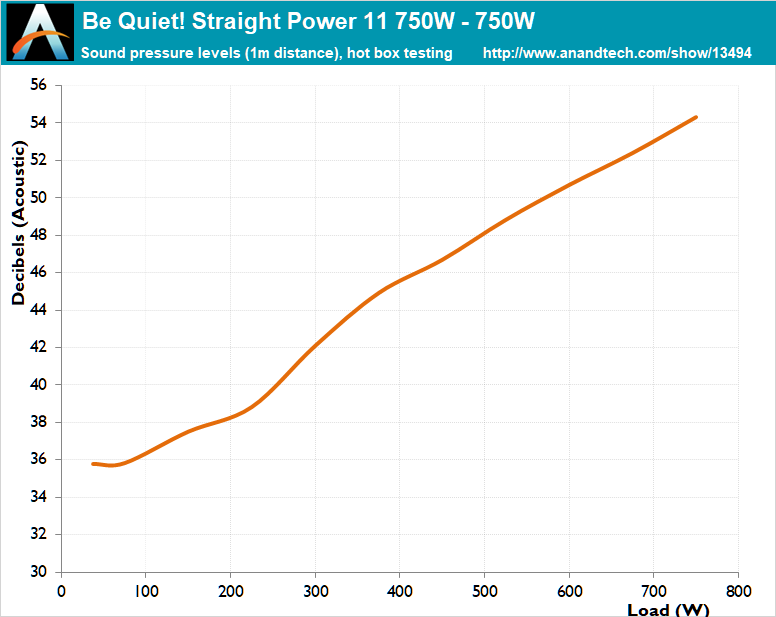








4 Comments
View All Comments
Death666Angel - Wednesday, November 7, 2018 - link
Thanks for the review! I generally like BeQuiet stuff. I have a Dark Rock Pro 2 that I bought used for cheap as my CPU cooler and a Straight Power E9-CM 480W PSU that I also bought cheap used. That gives me a pretty much silent PC in combination with a Core i5-4570S @ 1V @3.6GHz and a 960 GTX graphics card. This seems to have missed its mark a bit, they are usually pretty good about the noise levels. Their Dark Rock Pro coolers trade blows with Noctua ones while usually being a bit quieter.One thing I would like to ask about this statement: "the efficiency diving below 75% when the load is lower than about 40 Watts."
Will you be able to maybe give us an article detailing idle power consumption of current generation (maybe even older generation) hardware, to see how relevant such a deficiency is? If I were to buy a 750W PSU, it would be for a top of the line overclocked 8 core CPU and a smiliar, top of the line overclocked GPU. A reasonable overclock on air would likely still mean the system draws less than 500W with a handful of HDDs/SSDs and no weird stuff. What would be the idle power draw of such a system. Maybe compare an overclock via offset to one via fixed voltage? Is 40W a reasonable target for idle power draw of modern, high end systems? How are the default BIOS settings regarding power saving mechanisms set?
And to be fair to BeQuiet, at 40W, the absolute power consumption of the PSU is still rather small. The Corsair SF450 Platinum has about an 80% efficiency rate at 40W (cold test) and the BeQuiet about 70%. If my maths checks out, the power draw at the wall is 57W vs. 50W. If your PC idels 24/7/365 at German electric bill prices (about 24C/kWh for me), you'd pay 14€ more vs more efficient designs. Yes, it's a deficiency they need to work on for the next generation, other manufacturers are better about it. But I'd still pick this PSU than one bundled with a standard PC case or one from Thermaltake, Chieftec, LC-Power and other more or less no-name brands without reviews. :)
Gastec - Thursday, November 8, 2018 - link
My old PC (i7-860, GTX 670, 8 GB DDR3 1600 MT/s, two SSDs, one HDD, 1 cpu fan, 2 case fans) idles at 35-40 W. According to this article https://www.anandtech.com/show/11180/the-nvidia-ge... their system with a GTX 1080Ti idled at 76 W. Other newer systems out there seem to idle at ~90-95W (which I find a bit too much).On Amazon.de: the be quiet! Straight Power 11 750W is €125, the Corsair SF-450 Platinum costs €108, but it's a 450W PSU. The 600W SF-600 Platinum costs €120.
The least expensive Corsair 750W Platinum PSU, the HX750 is €140.
Ravenmaster - Wednesday, November 14, 2018 - link
Last month I RMA'd a bequiet! Silent Loop 280mm CPU cooler because after 2 months the pump went faulty and started rattling like mad. This week I had to RMA my bequiet! Dark Power Pro 11 (1200w) because it was making a popping sound when i switched it on, followed by sparks coming out of the back. Had put my old EVGA PSU back in and switch the CPU cooler for my old Corsair H100i. The older parts are louder but at least they're not faulty and they do the job. Never gonna buy bequiet! components again. Their case fans are second to none but their components are trash for some strange reason.s.yu - Wednesday, November 21, 2018 - link
Hence the exclamation mark? ;)